“There! Did you see it?” I exclaimed in excitement, scrambling for my binoculars. Our host, naturalist Jugal Tiwari, who had the same view as mine from the seat ahead, replied, “No!” Our driver Chetan stopped the SUV we were travelling in. By now, I had the eyepiece of my field glasses cupped to my eyes and I was scanning the spot where I thought I had spied a Desert Cat. Seconds turned to minutes. The sun was withdrawing from the westernmost district of India. All I could see was dark brown, almost black clumps of grass, and brown, almost grey sand. We moved further towards a sparse thicket of dead thorn trees and vilayati babul (mesquite or Prosopis juliflora).
A throbbing began in my head. The battering ram of doubt started to pound the fragile gates of my mind fortress. What had I seen? A ditch appeared ahead. I felt the creature might have slipped away into it. But no. It was not there, it was as if it had never been. But I had seen it. It had a dark pelage, and darker spots. It was evidently in a rush — I had seen it gallop on all fours, bringing its feet close together on the ground, front and hind paws far apart in the air, tail gliding behind like a pennant. I took in all of this in the less than five seconds I had glimpsed it. But it never reappeared.
Against the setting sun, the features on the landscape around us were indistinguishable. We started back for CEDO. We returned via the village of Lorai, which is located on an active seismic fault. Kutch is a delight for the geography enthusiast. There is the desert, there are extinct volcanoes, and there are frequent tremors that keep the seismograph ticking. There is an interesting notion that the river Indus had its mouth in Gujarat and an earthquake changed its course a hundred kilometres to the west.
It had been a long day that had started early. We had headed deep into the grasslands looking for Spotted Sandgrouse (Pterocles senegallus), that were visiting a water holes. We savoured the sighting for it had completed the triumvirate of sandgrouse found in Kutch. We had learnt and experienced their remarkable social adaptation. We saw sandgrouse with assigned duties of scouts and sentries looking out for danger while the sandgrouse in the group tanked up at the watering hole. There weren’t the only ones we saw with the social defence. There were the Indian Desert Jirds, whose colonies we had seen aplenty across Banni.
Cohesion is not the only adaptation of the jirds, I noticed. They blend with their environment like a Draco lizard on a tree trunk. I had a hard time spotting them. Their ginger fur made them inconspicuous on the dug up earth around their burrows, even when they were close.
Contrast this with the raptors we saw, which hunted solo. The Steppe Eagles, Montague’s Harrier, Pallid Harrier and the Black-shouldered Kite gave enough space to others of their ilk.
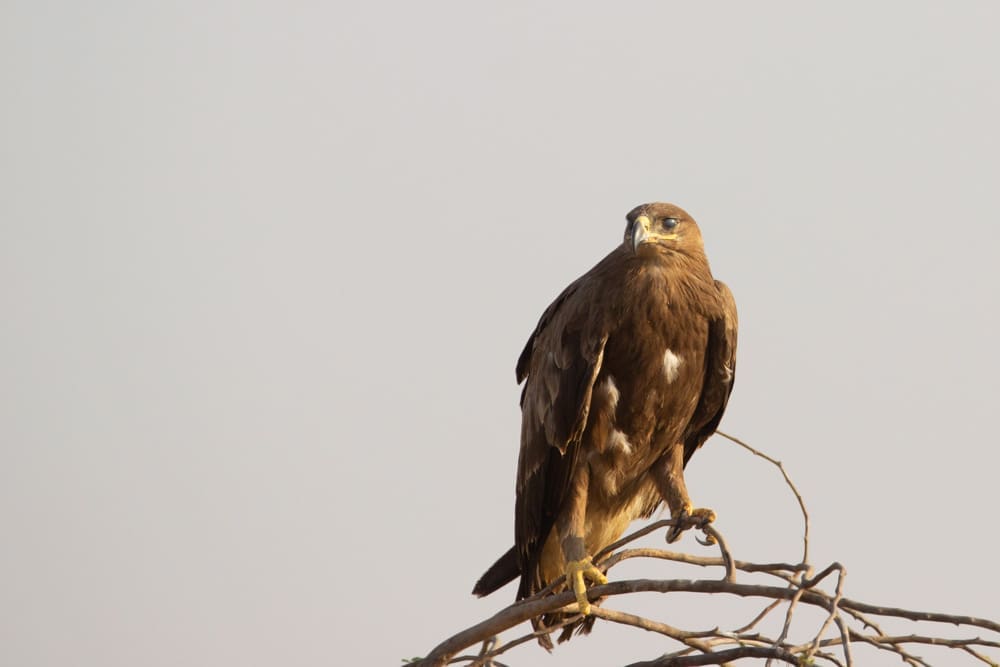
In the late afternoon, we had just finished an enriching sighting of the White-browed or Stoliczka’s Bushchat. I was confident I had cashed-in on my lifer luck credits for the day. And then I saw a bird run about two hundred metres away. At first it didn’t make sense. The dry grass was dense, but the bird’s long neck with a black patch on the nape gave it away. Slender legs, heavy back, long neck, zig-zag running style. Bustard? I got the confirmation from Jugal who was sitting in the front passenger seat. Indeed, it was the MacQueen’s Bustard (Chlamydotis macqueenii) also known as the Houbara Bustard, a winter visitor to Kutch and a bird actively persecuted in neighbouring Pakistan by means of an insidious hunting industry.

The bustard sensed us from a distance and took off, disappearing behind a dense wall of mesquite trees. It had a flight hard to describe; to me it appeared like a para-glider, flying in circles with the wingtips turned downward. Chetan drove the SUV closer to the thick patch of babul, I assumed this is where we turned back, but the jeep track went through this opening into what appeared to be an endless expanse of grassland specked with more babul.
The jeep track through the babul trees was a portal into a new realm. Here the tall dry grass and the babul trees alternated as though intentionally positioned there. Very different from the largely uniform grasslands that we had seen earlier in the day.
Diminutive claws had dug up the coarse sandy soil at several places. A tenacious miner had been at work. Small, tan and furry. The multiple hubs of holes in the ground gave a hint of the social life of the Indian Desert Jirds (Meriones hurrianae). We stopped near one of these colonies and saw a jird emerge and retreat in alarm. It wasn’t expecting unannounced visitors, I gauged. We withdrew politely, but there was another visitor lying in wait, persistent and expecting to make a meal of the residents in the colony.
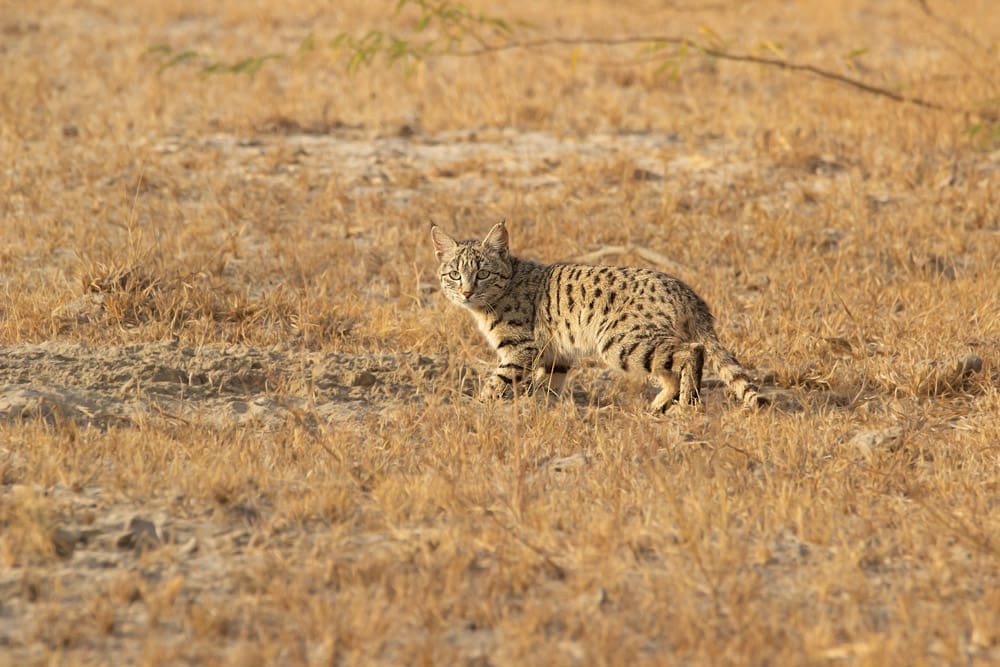
We drove a few metres away when Jugal called our attention to the dry grass between the babul trees. He was pointing to a Desert Cat (Felis silvestris ornata) in the grass which I couldn’t see through my binoculars. We moved closer to get a better view. At the same time, the Desert Cat emerged in plain sight. Its chest glowing in the angular rays of the setting sun, it regarded us in acknowledgement of our presence.
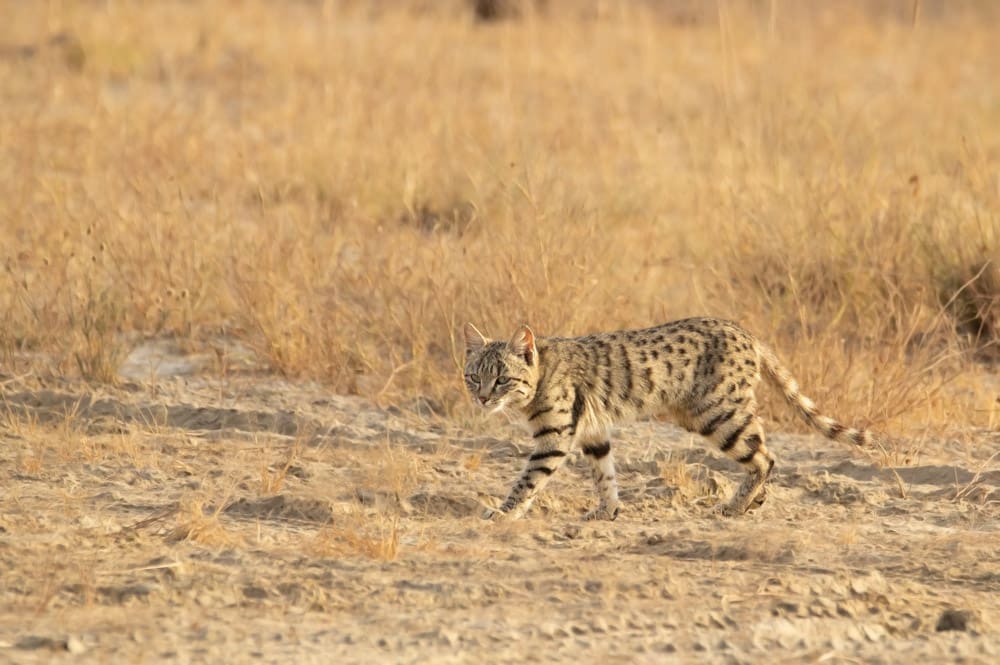
From here began nearly half an hour of hide and seek. The Desert Cat was aware of our presence; however its actions alternated between caution and aloofness. It emerged in plain sight at times, while at other times it concealed itself in thick grass in the shade of a babul thicket.
About twenty minutes after we had first spotted the Desert Cat, it came out in the open and upon a jird colony. We saw, during this close encounter, the Desert Cat’s pale brown fur with dark spots, and the lynx-like tufts of stiff hair behind the ear. A dark line extended from the extremity of each eye along the cheek and ran parallel with another line just below. The lines across the cheek reminded me of an Apache warrior out to battle. We waited for Operation Vermin Ravage to commence but this Desert Cat hunted like an amateur, crouching low near the mouth of a burrow and pouncing on its intended prey in typical feline style. At times, it would tiptoe stealthily towards the mouth of the next burrow. It didn’t seem serious about its meal, for it gave up within minutes. Its patchy hunting skills evinced that this was no Apache we were looking at.
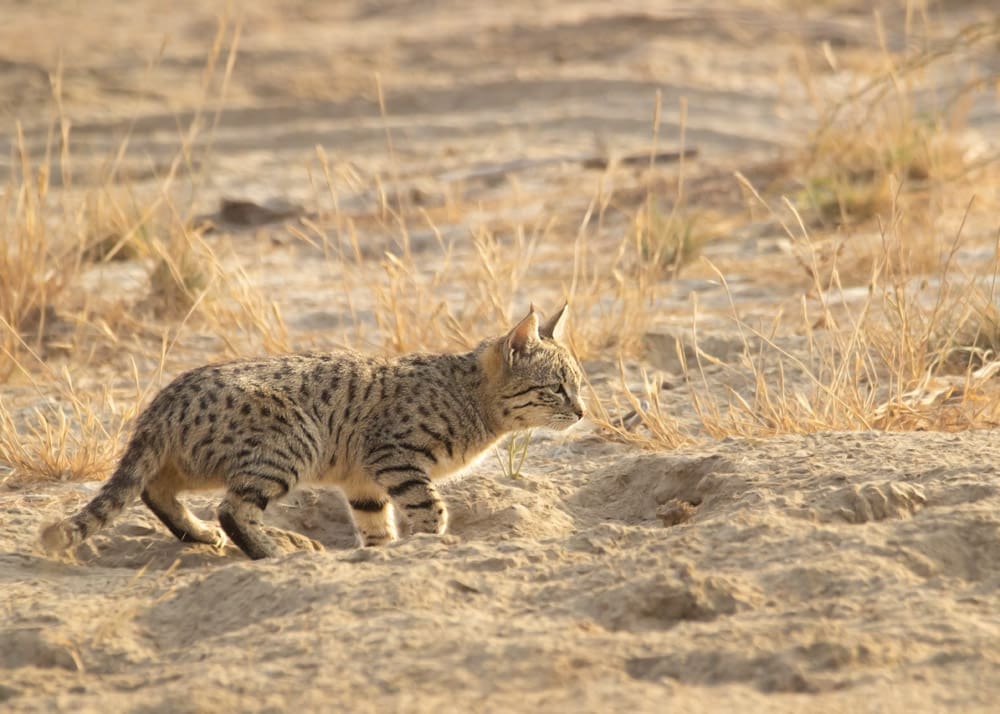
Just as we began to appreciate this close sighting it was overcome by another whim. It went into hiding again for a while and emerged, moving further from us. It ambled leisurely but with resolve. I noticed for the first time the landscape that lay beyond. The soil was firmer, a darker shade of brown. I saw a conspicuous absence of grass for about a hundred feet. Nothing was meant to grow in that patch, it appeared. The flowing water from the last monsoon had perhaps carved a shallow, winding ditch about a foot deep, and its walls appeared to be painted white with lime or salt, perhaps left behind by evaporation. The Desert Cat slipped into this shallow patchwork of brown and white, disappearing behind the bend.

We were immersed in this experience for about thirty minutes. The show over, we hurried back. With the Desert Cat no longer hogging my attention, I noticed the stillness in the air. Nothing stirred, not a wingbeat. The only airwaves were around our nostrils as we inhaled and exhaled.

The grass looked dry and tenuous, I bet I could have snapped it with a flick of my forefinger. But the desert grass is fibrous and resilient, and one has to twist and pull it and subject it to varying degrees of stress before it tears. The grassland at Banni too was being subjected to varying degrees of stress, and had so far displayed remarkable resilience. My rumination ceased as I was briefly distracted by a Hoopoe (Upupa epops) lit by the sun against the reddish-brown earth.
On our way back about ten minutes after the first Desert Cat sighting ended, Jugal spotted another Desert Cat. This one was larger than the first, and of lighter pelage. It was a brief sighting because half of the cat’s body was concealed inside a wide burrow, into which it ducked upon sensing our intrusion. Jugal directed me to be ready with my camera, saying “Watch now, its head will bob out of the burrow.” And bob out it did. I wished there was no grass in the foreground but I didn’t complain. It had been an action-packed day for us in the Banni grasslands.
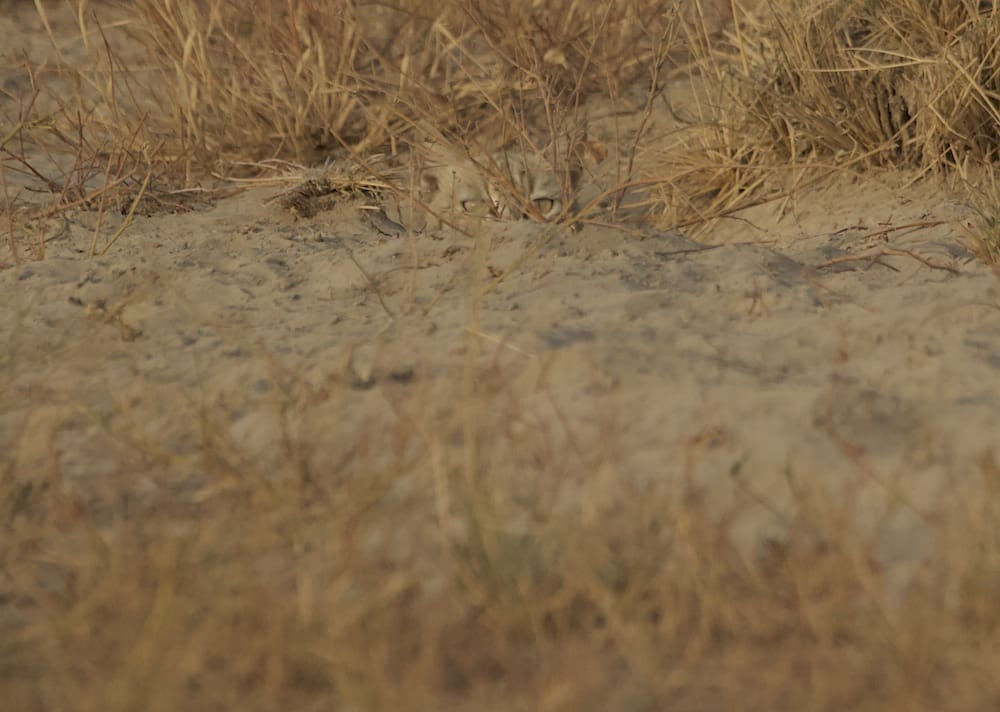
We had a long jeep track to cover on our way back and the sun was setting fast. There was enough light for us to look around, but the shadows were taking over. Two Desert Cat sightings is as fortunate as it gets, I told myself. Patches of clouds obscured the sun and the light was now diffuse, the contrasts reduced. Chetan shifted to a lower gear to navigate an uneven stretch of the track and the scene outside slowed down.
I drew a deep breath, rested my head on the backrest, and turned my head to my left, my gaze on nothing in particular. And I said in excitement, scrambling for my binoculars, “There! Did you see it?”
- Kutch Diaries – Spying on the elusive Desert Cat - June 10, 2020
- Kutch Diaries: Up close with the raptors of Banni - May 24, 2020
- Kutch Diaries – Going Waku Waku with Sandgrouse in Banni - April 29, 2020

TGO seems to have all the sightings luck! Fabulous write up again… I might recall this as a personal sighting with vivid with details as I grow older.